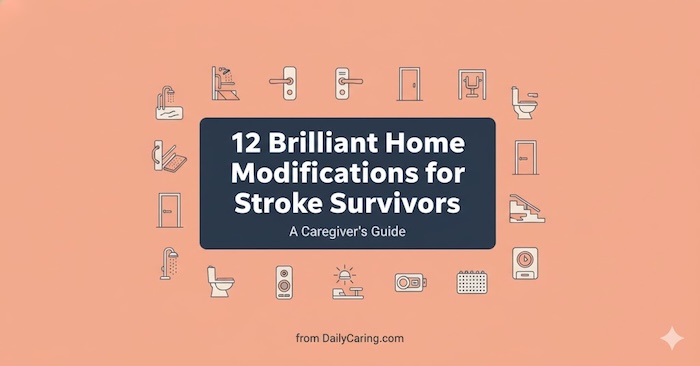Falling isn’t a regular part of aging, but falls are the leading cause of serious injuries among older adults. Caring Senior Service discusses the three most dangerous rooms for falls and shares simple fixes that reduce fall risk.
As the number of Americans choosing to age in place increases, so does the number of older adults who fall at home.

The U.S. Centers for Disease Control and Prevention notes that falls are the leading cause of fatal and nonfatal injuries among older adults. The CDC also notes that billions are spent on medical costs for non-fatal fall injuries, and $754 million on deadly falls.
Falls are Not a Normal Part of Aging
The most important thing to remember is that falling is not a regular part of aging. Falls are a symptom of homes that have not been modified to accommodate an aging-in-place population.
By taking a few safety precautions, we can reduce the number of falls and keep our loved ones healthy and happy at home.
To maximize senior fall prevention, we discuss the three most dangerous rooms and share simple fixes that reduce fall risk.
Three Highest Risk Rooms for Falls
1. Staircases are high-risk areas for falls
If your older adult lives in a two-story home, the risk of falling on a long staircase is probably apparent.
Even if they live in a one-story home, there may be steps elsewhere in the home you might not consider when fall-proofing, such as two steps down to the living room.
Many houses have two or three steps leading to the porch or to other steps in the yard or garden.
Ensuring that all the home’s stairs have handrails on both sides of the steps can help prevent falls.
In addition, it’s essential to remove clutter from the staircase and to glue or nail non-skid treads to the steps.
Ensuring every staircase is properly lit also helps prevent missteps, which often lead to falls.
Try some simple stick-on LED lights with motion sensors – they’re great for automatically illuminating stairs and walkways.
Outdoor concrete staircases can pose a challenge for seniors because they are prone to ice buildup, more likely to chip (which can cause trips or stumbles), and harder to keep clear.
In addition to ensuring these staircases have handrails, you can also securely fasten non-skid aluminum, rubber, or wooden treads to these types of steps to improve traction.
If they’re in an area that gets heavy snow and ice during the winter, it’s essential to arrange for their outdoor steps to be shoveled and/or salted regularly.
2. Bathrooms are high-risk areas for aging adults
The bathroom is one of the most frequently used areas in any home and a common site of falls.
Your older adult not only uses water in this room but is also often barefoot, which can reduce stability.
Add these risks on top of the fact that they are regularly going from a standing to a sitting position (and vice versa), and you have a fall waiting to happen.
When more than 230,000 people are injured in the bathroom each year, you can be assured that it can be a dangerous place for older Americans.
Keeping the bathroom floor free of clutter, adding self-adhesive non-slip treads to the bathtub, shower, and floors, and wiping up spills are common-sense ways to keep your mom or dad safe there.
One of the best ways to help your older adult maneuver in the bathroom is to install grab bars. They are a cost-effective and straightforward solution that can be easily installed in any bathroom to provide support and stability.
This reduces falls and helps prevent serious injuries. Top locations for grab bars include tub and shower areas and alongside the toilet.
If you’re unsure of the exact location to add grab bars or how to install them correctly, contact a local contractor or consult with an expert at a home improvement store. Proper placement and secure installation of grab bars are essential to preventing falls in seniors.
3. Bedrooms can be dangerous for aging adults when it comes to falling
Bedrooms can be hazardous to seniors aging in place. They’re often poorly lit, may have loose rugs as decorative accents, and are the places we frequent when we’re tired and not particularly alert.
Getting into and out of bed is difficult for many seniors due to medications taken before bedtime or because their bodies stiffen after resting.
Adding grab bars to walls near the bed (or a no-install, free-standing grab bar) or purchasing a bed with built-in bedrails will help seniors get safely into and out of their resting area.
It’s also vital to replace slippery throw rugs with non-slip mats to help your loved one maintain traction.
And, because humans often wake in the middle of the night to use the restroom or get a glass of water, the darkness of the room can put your loved one at risk.
Adding nightlights or motion-sensor lights throughout the room can help your older adult see their path in the dark.
Your older adult’s dressing area can also be dangerous if items are outside their reach.
Moving everyday items from the top shelves of the closet to more convenient locations can help prevent your older adult from losing their balance while reaching. Your loved one may also benefit from a reaching tool that can grab items off high shelves.
Final Thoughts on Fall Risks in the Home
Preventing falls at home isn’t about creating a sterile, clinical environment; it’s about thoughtfully adapting the spaces where your loved one lives and moves every day. By focusing on the three most hazardous areas – bathrooms, stairs, and bedrooms, you target the majority of risks with simple, effective changes.
Each grab bar installed, each rug secured, and each nightlight plugged in is more than a safety measure; it’s a building block for confidence and independence. This proactive approach transforms worry into action, creating a home that supports their strength and autonomy.
Remember, the goal is to make safety a seamless part of daily life, allowing them to move freely and securely through the home they love. Start with one room this week, and build a foundation for a safer, more confident future.
Recommended for you:
- 10 Simple Fall Prevention Exercises Seniors Can Do at Home
- Increase Senior Independence with This Fall Risk Checklist
- 2 Fall Prevention Exercises for Seniors: Improve Balance While Reaching
Guest contributor: Caring Senior Service founder & CEO Jeff Salter began his career in senior care in 1991, working for a home health care agency in Odessa, Texas. Four months later, he started his own senior care service to provide seniors with the non-medical care they need to stay at home. In 2003, Caring Senior Service began offering franchises and today has nearly 50 locations across the United States.
This article contains some affiliate links. If you buy through an affiliate link on our site, we may earn a small commission, at no additional cost to you. For more information, see How We Make Money.













The inner ears are the body’s balance between center. To prevent falls, adults must have audiological evaluations early and often. By not including this very necessary and vital procedure, the CDC fails when it puts out information. Baseline and annual hearing tests by a qualified audiologist are an absolute must!